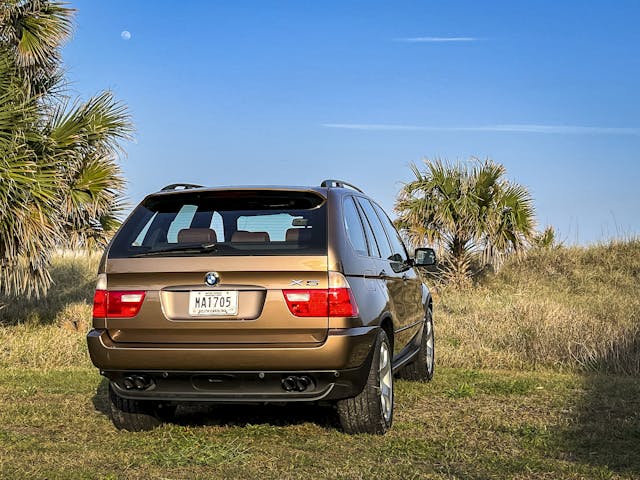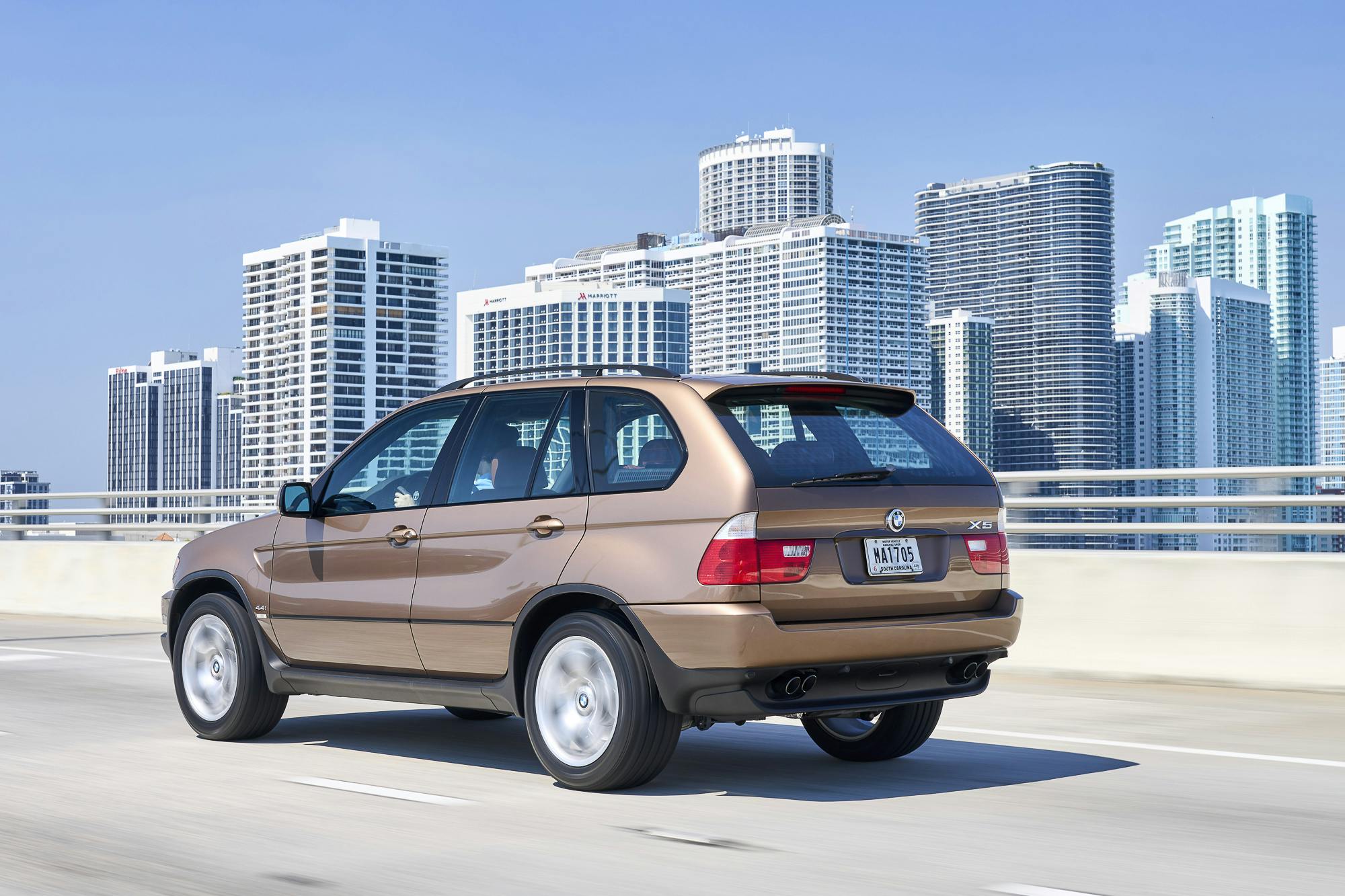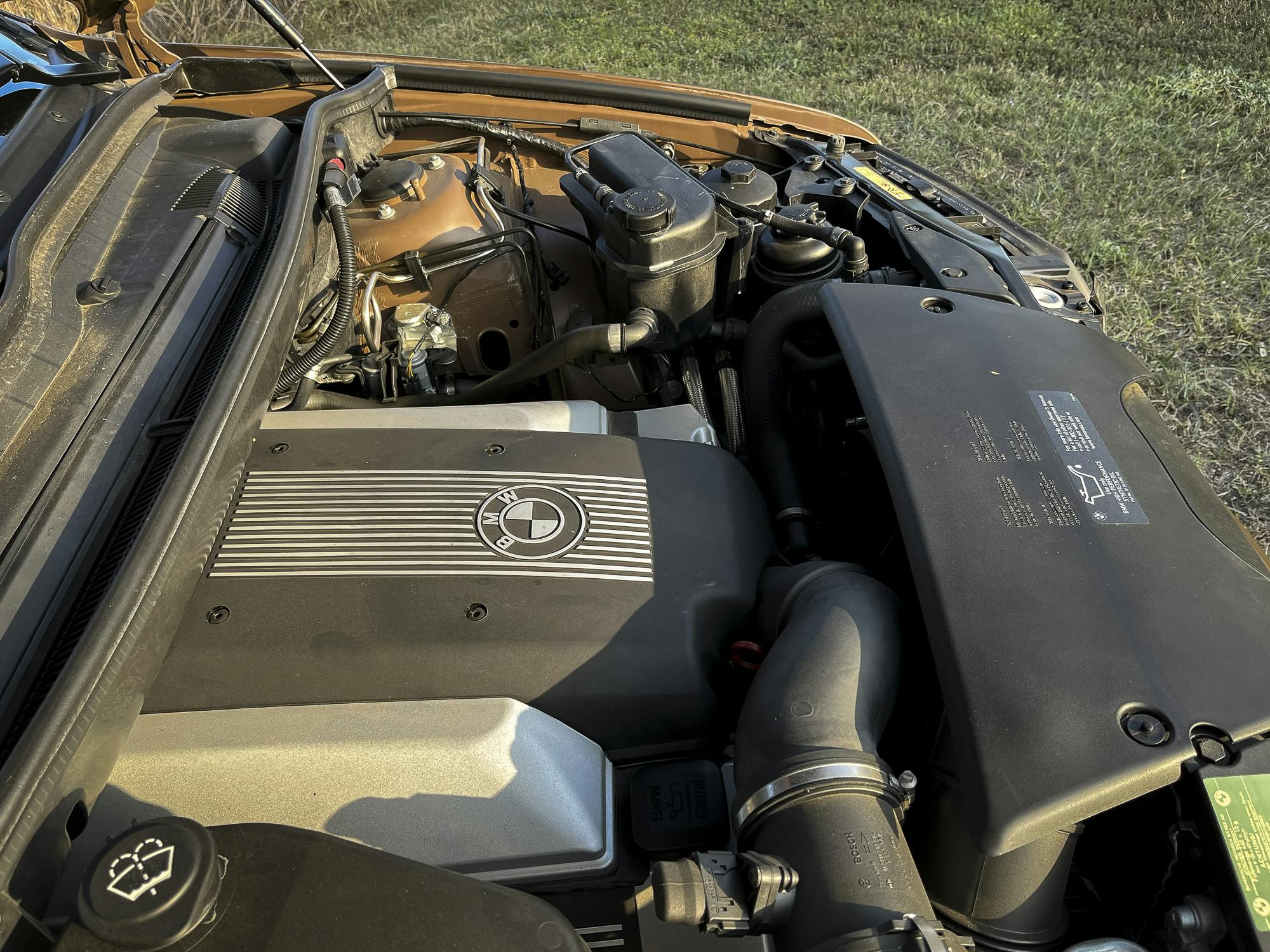Media | Articles
Is the X5 the next collectible BMW?
If BMW ever had a true golden age in which more or less every car in its lineup was at the top of its game, there’s a real case to be made for the turn of the millennium. In 2000, BMW offered the sporty E46-generation 3 Series, the sophisticated E39-generation 5 Series, the timeless E38-generation 7 Series, and the retro Z3 roadster. Essentially all of these vehicles have come up in value in recent years, suggesting a renaissance of interest. Looking back on the last 25 years, however, a different vehicle altogether arguably had the biggest influence in shaping the BMW we know today: the original E53-generation X5. Might it soon become a coveted collectible?
A collector luxury SUV?! Gasp! If we’re not clutching pearls here, it’s because this notion should no longer seem far-fetched to those paying attention. Leaving aside the fact that few imagined, say, a Subaru WRX or an Acura Integra Type R would ever sell for huge sums, a contemporary X5 rival is already carving out a niche in the collector conversation. We’re referring to the Porsche Cayenne, an SUV which launched a few years after the X5 but is already swept up in the vortex of Porsche enthusiasm. A lot of the Cayenne craze centers around safari-style off-road builds, which plays into the vehicle’s reputation for overengineering and durability.
In keeping with BMW’s reputation for sportiness at the time, the X5 was more celebrated for its impressive on-road handling. Maybe that’s why BMW marketed it as an “SAV” rather than an “SUV” (A for Activity). Or maybe it’s because the trunk was so pitiful for a big crossover that nobody in Munich could honestly allege that utility was the point of the exercise.
The true point, of course, was profit. Remember—BMW had acquired Land Rover in 1994 and was keen to make good on its investment. When it launched in 1999, the X5 featured many of the same electronics, infotainment, and powertrains as the 5 Series. However, the split tailgate, hill-descent control, and general luxury-hunting-rig vibe were straight from the Range Rover playbook. Along with wanting to utilize its recently-purchased British asset, the market was beginning to hop with competition. Among the Germans, Mercedes-Benz hit the scene first with the ML-Class in 1997, —the first vehicle to be built at the brand’s U.S. factory in Alabama. Lexus followed the next year with the incredibly successful RX300.
The X5 was built in Spartanburg, South Carolina. That both Mercedes and BMW opted to build new SUV factories on our shores was not a coincidence; Americans were very much the target market. Sales were strong right out of the gate, with 26,270 X5s sold in 2000, the first full year in showrooms. That’s a fantastic result for what was at the time a genuine oddball at BMW dealerships, and an expensive oddball at that. Launched only with a 4.4-liter V-8, the X5 started at $49,970—that’d be $90,532 now. BMW fleshed out the lineup the following year with a 3.0-liter straight-six version, costing $38,900 ($68,185 today). Year-end press releases at the time touted record sales, including a 58 percent increase in 2000. The dizzying roster of X- models in BMW dealerships today all began with the success of the E53.
Marketplace
Buy and sell classics with confidence
Among these early X5s, the rarest is the Neiman Marcus Edition. Sold exclusively via the department store’s 1999 Christmas Book, all 50 examples were finished in Impala Brown Metallic with standard 19-inch wheels, park-distance sensors, navigation, Xenon headlamps, heated front seats, and a 10-speaker sound system. The experience included driving training at the new BMW Performance Center in South Carolina, a group romp on the Blue Ridge Parkway, and a tour of the Biltmore Estate in Asheville. Pinkies up, everyone!
As special editions go, it’s not all that special. For one, the powertrain was the same 282-hp, 324-lb-ft V-8 engine and five-speed automatic transmission as the standard X5 4.4i. Still, we relished the chance to drive the very first of these brown bombers for a few hours during The Amelia last month. The vehicle belongs to BMW’s collection in Spartanburg, and at the time of our drive the odometer read just 800 miles. It’s not difficult to imagine this being the lowest-mileage Neiman Marcus X5 in existence, and among the freshest E53-generation X5s overall.
The first thing I notice is just how elegant the X5 looks in a parking lot, despite its considerable size. Designers Chris Bangle and Frank Stephenson nailed it. Lines are sharp but not aggressively so, and the design’s sheer clarity has held up much better than the first ML or Cayenne. I open the door and remark on the sheer heft of the thing, similar to an old Volvo or Mercedes. They shut with satisfying thunk—the kind that stamps an exclamation mark on the end of a heated argument. Gorgeous inlaid wood appears all over the cabin, wrapped around the steering wheel and center console with a delicacy not seen in today’s models. The storage cubby behind the gear selector snaps open quickly and clicks back audibly into place. Door pockets would have seemed enormous to 5 Series drivers. Typical of BMWs in this era, the gauges are all easy to read and clearly framed by the space inside the steering wheel.
Quality padded leather or solid-feeling plastic covers essentially every other surface with which you interact, though the reddish brown seats and trim don’t visually gel here. Every other Neiman X5 I can find online had a light beige interior, also specified in the original press release, so I suspect this color theme may have been reserved for this BMW-owned example. If there’s any downside to the interior, aside from the small trunk and the impossible-to-locate lower tailgate switch, it’s that the back seat is considerably more cramped and less comfortable than the fronts.
Compared with a modern X5, you feel like you’re driving a truck. The seating position is high, but visibility is excellent all around thanks to large windows and a clear perspective over the hood. Inputs require muscle, and the steering weight is heavy and purposeful. At the time I imagine this would have been frustrating to maneuver around a parking lot several times a week, but as an occasional driver today I’d chalk it up to part of the charm.
It’s not especially quick—BMW claimed 7.5 seconds to sprint from 0-60 mph—but the X5 is more about momentum. It handles with surprising poise for something this tall and weighing 4800 pounds. Brakes are right there, every time, clamping down with consistent and predictable force.
While working for Car and Driver in 2000, Hagerty special projects editor Steven Cole Smith drove a Sport package X5 for more than 2500 miles on a road trip. He disliked the Sport’s stiff suspension but voiced praise for the powertrain:
“The VANOS variable valve timing is seamless and transparent. Mated to the five-speed automatic ZF transmission, the powertrain is well-matched, downshifting intuitively when needed, upshifting without drama. It has the Steptronic feature that allows you to shift for yourself, but to some of us, it seemed more a novelty than an enhancement.”
Smith’s criticism holds up nearly 25 years later. The main difference is that this is a slow-shifting transmission by modern standards, but the remains quite a usable powertrain both around town and on the highway. The V-8 has a patient confidence, but even stomping the throttle pedal doesn’t make the car feel over-taxed.
By many accounts, the taxing came later, when the car went out of warranty. These cars can be useful for many thousands of miles if fastidiously and proactively cared for, but maintenance costs are considerable. For one, there are many reports the X5 going through tires like a college freshman through a super-pack of Top Ramen. Owners of the E46 and E39 can also attest to the fact that BMW electronics from this era don’t hold up terribly well, and the X5 shares many of those cars’ other common issues, coolant leaks being the most common of them. Expect high labor costs for anything involving the permanent all-wheel-drive system, timing chain guide rails for the V-8, and optional self-leveling air suspension.
First-gen X5s are generally more affordable than comparable Cayennes, and well-used examples are readily available for under $10,000. That said, savvy buyers will wait for the right car to come along—one that has been thoroughly cared for and maintained. Paying a premium up front will likely mean avoiding nasty surprises down the road. A qualified inspection is essential.
We know millennials are particularly fond of sporty BMWs from this era, but Hagerty insurance quotes for the E53 X5 suggest an older demographic: Gen X. Factors here could be willingness to deal with the maintenance costs, a greater focus on luxury than sportiness, and a higher priority on comfortable ingress/egress. It’s easier to load up kids or grandkids in an X5 than a 5 Series.
For now, the first-generation BMW X5 is in the very early stages of becoming a collector machine. Interest is growing, though, as Hagerty manager of valuation analytics John Wiley explains:
“A couple of years ago, Hagerty gave insurance quotes for the E39-generation BMW M5 more than five times as often as the E53 X5. That was despite the X5’s average quoted value of $16,800—less than half that of an M5. When we do that calculation in 2023, that advantage for the M5 is now just 3.5 times as many quotes.”
We’d expect V-8 versions of the X5 to remain more collectible than the inline-six examples. Though the Neiman Marcus X5 could well hold appeal for the luxury crowd, sport-minded buyers will naturally gravitate to the late-model 4.6is. A kind of proto-X5 M, this über-E53 shaved its 0-60 time down a full tick, to 6.5 seconds, thanks to its 0.2 liters of extra displacement, 340 horses, 20-inch wheels with wider tires, and plastic wind foils. When new, the 4.6is cost $66,845, which was $15,200 more than a 4.4i Sport.
With the rise of 1990s and 2000s European cars in full swing, and the market for vintage SUVs truly becoming a fixture of the collector landscape, the X5’s time will come. I, for one, look forward to witnessing this brutish, Bangle-Stephenson beauty earn its seat at the table.
***
Check out the Hagerty Media homepage so you don’t miss a single story, or better yet, bookmark it. To get our best stories delivered right to your inbox, subscribe to our newsletters.











































































A collectable SUV?…Haha ‘you’re funny!
^never seen an old Rover Classic or Land Cruiser(80’s/90’s) fetch 40k+? Just bought an imola red 4.6is, and can 100% tell you the interest in these cars will grow. However, they did make close to half a million e53s.. so there’s that working against it… but only 3000 4.6is models worldwide.
I normally keep all of my cars for 10-15 years and usually pass them along to my family. My 2005 X5 Sport package 3.0L was my first BMW. #1 crash rated SUV in the day. Handled great. But it will be my last. Every couple of months it was at the dealership for warranty work. Among the things that failed within the 4-year warranty period were: windshield seal, Navigation system display, power steering hose, Front CV joint, mass airflow sensor, and throttle position sensor. After warranty: Crankcase oil separator housing, front door handle and front rotors warped. I got really tired of the limp home mode and the transmission protection mode. Kept the car 6 years and sold it with only 48K miles on it. I called it a BM Trouble you. We now own 2 Lexus SUV’s instead.
With 2 e46 330 convertibles (one a ZHP), two e39s (M5 and 528) and an X5 4.8is, the X5 is probably my favorite of the bunch. Maybe a unique perspective given that mixed company but the X5 has clear differentiation with it then-competitors and helped start the trend toward well mannered “trucks”. Certainly hoping for collector status as I have no intention on selling any time soon.
Since it looks like every SUV from the side and rear, and only the grille separates this from the 428 billion boxes roaming the road I expect any collecting this will have their turn on the hoarding shows that are on cable TV. And I have said 14 billion times, I do not exaggerate.
Collectible? Sure. Do I want one? No. I would rather have the equivalent 3 or 5 series wagon.
I think the 4.8is might become the most coveted. For me, I like the practicality/economics of the 3.0. Reliable power train and decent towing capacity of 6,000 lbs.
Agreed.
The 4.6is and 4.8is E53’s will undoubtedly be the most coveted being the original pre “M” variants.
Whilst it should be noted that the E70 4.8 was not never the intended replacement to the above, but the 4.4.
Hi Mike,
I agree
I 100 percent think they under sold the 4.8is by not even getting a mention.
Get one soon. I’m going to put one on the car scene map, Young money will not invest in these, but us Gen X folks have the time to fix them. Only 62 examples of any color variant were shipped to Canada in 2005.
The people who like f85s wouldn’t have an M without the 4.8is e53.
I missed out on a chance to buy a silver/black ’06 3.0 with sport package and 6-speed manual. Dang it. It wasn’t fast, of course, but that 6/6 combo was silky smooth and made it feel like less of a truck.
My ’02 3.0 X5 is still going strong. Has been my daily driver since new. 235,000+ miles and counting. No major mechanical issues whatsoever.
I own a 2012 X5 with the inline twin scroll turbo six. It is my daily driver through the winter or when the weather isn’t nice enought to take my CTS-V or Roush Mustang convertible out during the non-winter months. I agree that maintenance can be expensive and I was apprehensive about all the horror stories about expensive cost of ownership, but with nearly 95K miles on the clock, this thing has been surprisingly trouble free. I did have the electric water pump go bad which is a known problem area with the N55, and aside from having to address a leaky valve cover gasket twice (another known issue), the rig has been surprisingly solid.
The N55 is widely considered one of the best engines BMW has put out. What I love most is how well it drives and handles. It doesn’t feel like a SUV at all, but more like a tall wagon. Steering is notably firm and acceleration is adequate compared to other cars on the road.
I keep thinking I should replace it with something newer, but the damn thing just keeps on going. Like a trusty old horse.
We used to own a 2010 Ford F150 and that thing ate us alive in repairs in the 100K miles we owned it. It would have been even worse if we didn’t have the extended warranty.
Maybe I’m the exception, but who would have ever thought I would say that my BMW X5 has been more reliable than a Ford F150?
Greetings Eric,
I thoroughly enjoyed the article, but I am left longing for the whole story.
I think the highlight on the Neeman versions were amazing and had no idea you could have purchased an x5 out of the catalog so to speak.
In the article there was great coverage of history of how the x series came to light up to the 4.6is. I was expecting to read about the final version e53 4.8is
Which in their last full production year 2005 produced 1492 examples in various color combinations.
Just wondering what a journalist at Hagerty really thinks the e53 4.8is going to do in the next 5 years here in 2024.
Thanks for your time.
Muskoka Bimmer